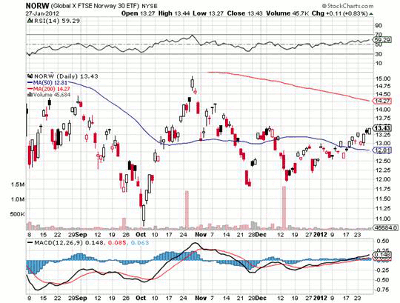A new ETF from iShares gives investors looking to capitalize on Norway’s economy—particularly it’s role as an oil exporter—another way to do so, writes Benzinga.com.
Considering it is the 25th largest economy in the world and considering that the iShares Sweden Index Fund (EWD) has been around since 1996, it took a while for Norway to get its own ETF. Until late 2010 in fact. That’s when the Global X Norway ETF (NORW) debuted.
Here’s a daily chart:
Well, it didn’t take all that long for the Global X Norway ETF to get some competition. NORW’s rival arrived earlier this week with the introduction of the iShares MSCI Norway Capped Investable Market Index Fund (ENOR), so there’s no time like the present to see how the two Norway-specific ETFs stack up. (It’s so new you may have trouble finding a chart until all the services update their databases.)
There have been times when Norway and NORW have provided headaches to investors. On the other hand, that might be by virtue of ignoring some cold hard facts, such as the fact that Norway is not a Eurozone nation, Norway is a winner under the $100 oil scenario because it’s an oil exporter, and the country has an unemployment rate of south of 3.5%.
See related: The Lone Factor Behind $100 Oil
As is the case with many of my ETF showdowns, NORW and ENOR are similar, but they’re not identical twins. Statoil (STO), Norway’s largest oil company, is the top holding in both ETFs with a weight of almost 22% in NORW and nearly 21.1% in ENOR. Along those lines, ENOR has the higher weight to the energy sector at 52% compared to 39% for NORW.
The Global X offering is cheaper with an expense ratio of 0.5% compared to 0.53% for ENOR. SeaDrill (SDRL), one of the strongest dividend plays in the oil services group, is included in both ETFs, however, it receives an allocation of almost 7.5% in ENOR compared to 5.7% in NORW.
That has led to talk ENOR could feature a decent yield. However, that impact may be muted as Statoil features 3.7% yield and has a larger weight in NORW, yet NORW’s yield is just 2.85% with both Statoil and SeaDrill accounting for over 27% of that ETF’s weight.
ENOR holds 51 stocks, making it larger on that basis than NORW, which is home to 30 stocks. At the sector level, financials at almost 12.8% are the only group that receives a double-digit allocation in ENOR. On the other hand, NORW gives double-digit weights to financials, materials, telecom, and consumer goods names in addition to energy.
Either way, both Norway ETFs can be viewed as developed market plays on rising oil prices and increased materials demand. That can translate to some volatility. Using NORW as our guide, that ETF was trading over $17 in May, found its way down to $12 by August before rebounding to $14 only to slide below $11 in October. After all that, NORW resides around $13.30, but the ETF is off to a sound start in 2012, adding 6.2% since the start of the year.
New ETFs should usually be given time to mature, but iShares has a dominant market position that allows many of its new funds to flourish right out of the gate. So those looking for Norway exposure don’t need to ignore ENOR. That said, NORW’s lower expense ratio and superior sector diversity make it the preferable choice and the winner of this showdown.
By the Staff at Benzinga.com
This content was originally published on Benzinga.com by The ETF Professor.












